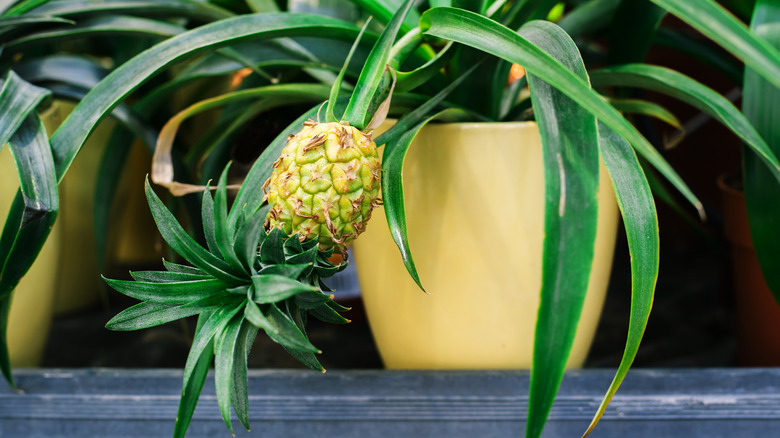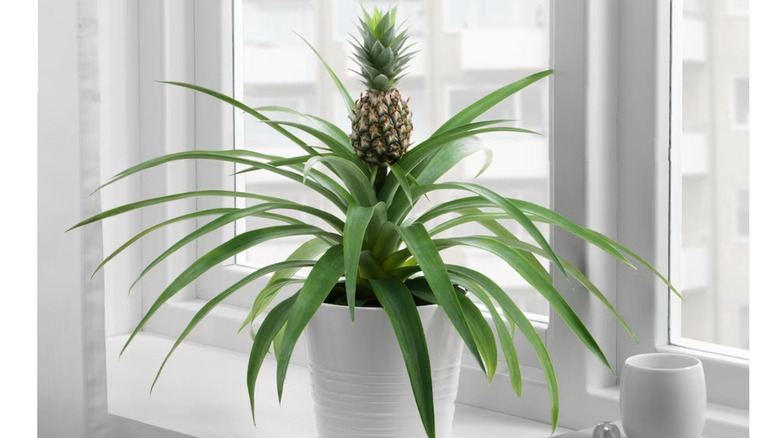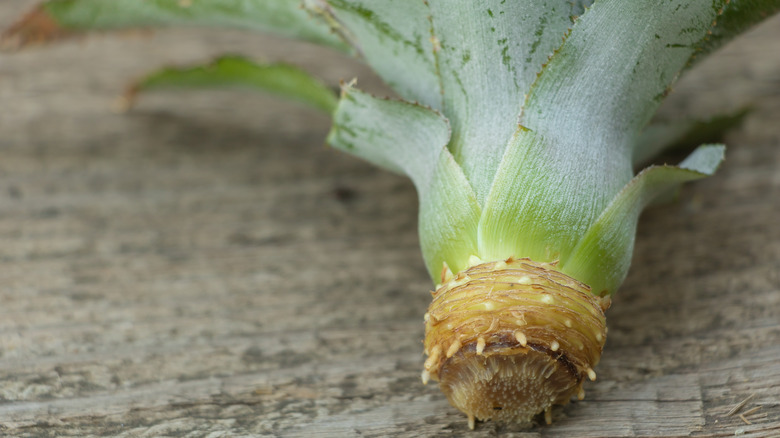You Can Get A Pineapple Plant At Ikea — Here's What To Know And How To Take Care Of It
Functional and innovative furniture store Ikea may not be the first place you think to go for gardening tips, but it turns out that the company's plant selection is prolific. For only $19.99, Ikea is now offering the ANANAS 5-inch potted pineapple plant. Only available for in-store purchase, these pineapple plants may not produce edible fruit, but you can't deny how adorable they are. This wouldn't be the first time in history that pineapples have been used for décor rather than sustenance. In the 16th century, when the fruit was first introduced to Europe, it was often used as a novelty item and seen as a sign of wealth since it could not be successfully reproduced until the 18th century. People used them as centerpieces at dinner parties and even carried them around as accessories.
The pineapple plant is native to South America and is a perennial part of the Bromeliaceae family. While some cultivars grow up to 6 feet tall outdoors, you can expect them to grow about half that size indoors and to only ever produce one fruit. But no need to worry; with the proper care, your plant will sprout plenty of pups for propagation that'll keep those tiny pineapples coming.
Caring for potted pineapple plants
Since the pineapple plant is derived from warm and dry climates with well draining soil, they prefer potting mixes similar to those of succulents and cactuses. Orchid mix is another commonly used and successful potting soil. Terracotta pots work best as pineapple plants are very susceptible to rot, and the clay will help prevent the excessive water retention that eventually leads to root rot. Bright, indirect light and temperatures ranging between 70 to 80 degrees Fahrenheit are optimal conditions. You shouldn't feel discouraged if you have picked up a plant with no sign of a pineapple yet. Pineapple plants produce beautiful purple and red coloring when starting to form the fruit, and you won't want to miss it.
These bromeliads absorb a lot of water through their leaves, so misting, in addition to watering, is an essential care tip. Waterings should be conducted when the top half of the soil has dried out, usually about once a week. Fertilizing can also be done up to twice a month using a generic indoor fertilizer on damp soil. You will naturally scale back the watering and fertilizing schedule as winter approaches. Repotting your plant as it grows is essential if you hope to produce more through propagation. It's also important to note that pineapple plants are not toxic to pets, however, you should still keep your pets from making them a snack to avoid tummy aches and digestion issues.
Growing your own from a store-bought pineapple
Unfortunately, when stores as popular as Ikea release trendy products, they can sell out before you get a chance to purchase one. If you've scoured the locations closest to you with no luck in bringing home a pineapple plant, you'll be happy to know that you can grow your own plant from an already picked pineapple purchased at your local grocery store. The crown is essential, so choose one with healthy foliage on the top. Grab some potting soil and a 6 to 8-inch pot while you're out. Once home, you'll begin by cutting off the crown of your pineapple as close to the top as possible.
Remove any pieces of fruit attached, along with the leaves closest to the bottom of the cluster. You should see little bumps on the base, known as root primordia, which are baby roots waiting to grow. Before potting the crown, you must wait for it to dry out completely. This can take up to two days and it should be dry to the touch when ready. Fill your pot with soil leaving a few inches of space at the top. Plant the crown 1 inch deep and fill the remaining space with soil, ensuring it's nice and snug. The roots can take up to two months to form, and the fruit three years to blossom. But few things are quite as rewarding as watching a plant grow from start to finish.


